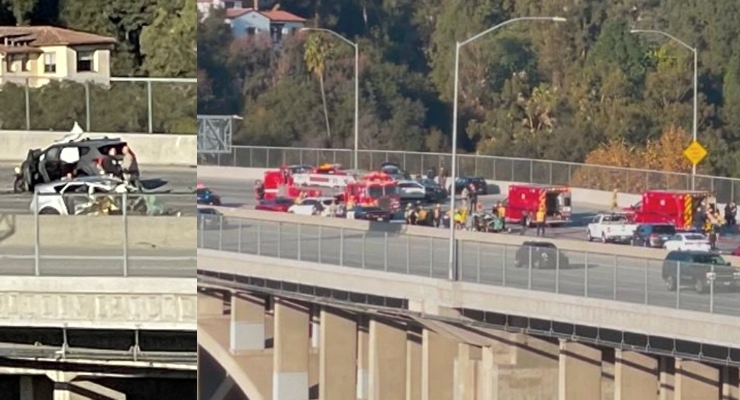 Beyond the 710, a community effort created to reimagine how to resolve the conflicts over congestion and mobility that have divided the western San Gabriel Valley for decades, blasted the Cost-Benefit Analysis recently released by Metro to support its SR-710 draft environmental impact report as “flawed” and “skewed”.
Beyond the 710, a community effort created to reimagine how to resolve the conflicts over congestion and mobility that have divided the western San Gabriel Valley for decades, blasted the Cost-Benefit Analysis recently released by Metro to support its SR-710 draft environmental impact report as “flawed” and “skewed”.
“We’ve been asking for a Cost-Benefit Analysis that honestly compares the alternatives in the EIR, but unfortunately, the Analysis released recently just continues what appears to be a strategy by Caltrans of putting the tunnel in the best possible light while discounting other alternatives,” said Ara Najarian, mayor of Glendale, member of the LA County Metro Board, and chair of Beyond the 710. “Essentially, this so-called analysis says that the more a project costs, the more the benefits will be. Well, that’s pretty obvious, and not the kind of analysis that can help policy-makers see what a dumb idea this tunnel really is.”
Among the criticisms of the Analysis that Beyond the 710 has identified are:
1) Valuing “Bigness” over anything else by falsely asserting that benefits “are typically examined independently of their relationship to costs.” In fact, if the alternatives were presented in terms of the ratio of benefit to cost, the results would show that the Transportation Systems Management and Transportation Demand Management (TSM/TDM) alternative provides the best ratio of benefits.
2) The Analysis inflates the operating costs of the bus rapid transit (BRT) alternative in a way that degrades its cost-benefit ratio. If the Analysis used the same numbers from the DEIR, the BRT ration would approach the TSM/TDM alternative in performance.
3) The Analysis appears to adopt a model that values the time of car riders over the time of transit riders, without any explanation, and as a result skews the results in favor of the tunnel alternative.
4) The Analysis purposely underestimates the cost of the proposed tunnel by half. Analyses of similar projects, most notably the one for the Sepulveda Pass, are using $1 billion per mile as a budgeting model, yet the 710 DEIR and CBA are using $500 million. This is another example of how the Analysis is skewed in favor of the tunnel.
5) The CBA and DEIR have no provision, plan or budget for the anticipated breakdown of the tunnel-boring machine. The same machine has been stuck in Seattle for over a year and is requiring a four-city block additional vertical tunnel to be excavated in order to free it. While of course we cannot be sure that the same machine would break down in a similar fashion here (despite geology that is, if anything, more challenging than Seattle’s), the lack of any contingency costs (again) skews the Analysis in favor of the tunnel. This is most obvious in that the Analysis uses the same discount rate for all the alternatives, which does not reflect the differential in risk among them.
6) One of the primary concept used in the Analysis, “Net Present Value,” is an inappropriate measure for public infrastructure projects.
7) The calculations used to come up with an employment benefit for the various alternatives is directly correlated to capital cost, skewing the benefits to the most costly alternatives. (Again, this is a fundamental problem of the Analysis, in that it unfairly favors “Bigness.”) Employment benefits are directly correlated to capital expenditures. The disparity in capital costs insures that the higher cost projects will generate more jobs than lower cost alternatives.
“Metro board members and other policy-makers should understand that this so-called Analysis appears to be a continuation of the skewed analysis unfairly favoring the tunnel that was obvious in the EIR,” said Marina Khubesrian, South Pasadena councilmember and Vice Chair of Beyond the 710. “It appears that an independent study of these issues may be necessary to get an unbiased view of whether this tunnel will be worth its huge projected costs. Obviously, we believe otherwise, and that instead Caltrans and Metro should study the Beyond the 710 proposal.”
The Beyond the 710 proposal was released on May 28, 2015. A key insight of Beyond the 710 is to understand that more than 85% of commuters exiting the 710 Freeway at Valley Boulevard are intent on reaching local destinations, and the vision of Beyond the 710’s plan is to use 21st Century planning solutions (such as well-planned transit lines, Great Streets concepts, and traffic mitigation) to reduce congestion and promote smart growth rather than 1960s freeway-oriented approaches.
The Beyond the 710 plan demonstrates that removing the freeway “stubs” at both the 10 and 210 freeways can free up land for smart development, employ transit to connect people to important local destinations and other transit lines, and employ modern strategies for increasing bikeability and walkability. The plan is available at www.beyondthe710.org/better_alternatives.
About Beyond the 710
Beyond the 710 is a project of the Connected Cities and Communities, comprised of the cities of Glendale, La Canada Flintridge, Cities of Glendale, La Canada Flintridge, Pasadena, Sierra Madre, and South Pasadena, and the National Trust for Historic Preservation and the Natural Resources Defense Council.
Beyond the 710’s Proposal is the result of many months of study and collaboration to seek solutions that work for all the affected communities. The effort was led by Nelson\Nygaard, a full-service transportation firm, with offices across the United States, committed to developing transportation systems that promote vibrant, sustainable, and accessible communities.
An Economic Benefits analysis produced by The Maxima Group LLC, a consulting firm specializing in real estate market and economic analysis, is located at www.beyondthe710.org/smart_growth.
Visit www.BeyondThe710.org for more information.














 0 comments
0 comments


